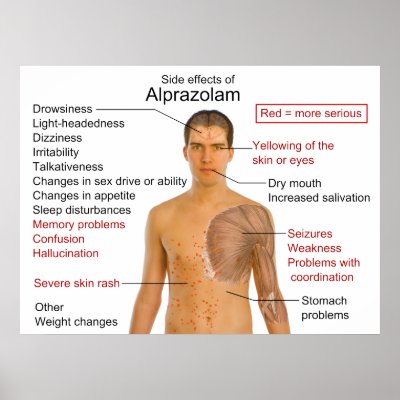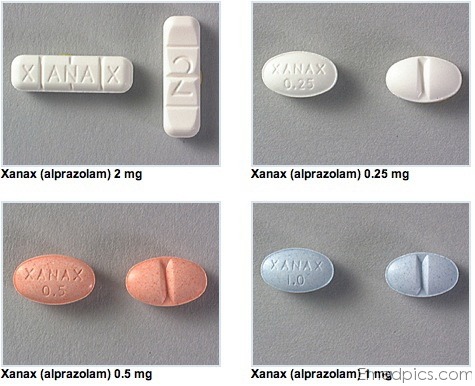ALPRAZOLAM
Description
Alprazolam (trade name Xanax, available among other generic names) is a short-acting anxiolytic of the benzodiazepine class of psychoactive drugs. Alprazolam, like other benzodiazepines, binds to specific sites on the GABA gamma-amino-butyric acid receptor.

8-chloro-1-methyl-6-phenyl-4H-[1,2,4]triazolo[4,3-a][1,4]benzodiazepine
Alprazolam is commonly used and FDA approved for the medical treatment of panic disorder, and anxiety disorders, such as generalized anxiety disorder (GAD) or social anxiety disorder (SAD). Alprazolam is available for oral administration in compressed tablet (CT) and extended-release capsule formulations. Alprazolam possesses anxiolytic, sedative, hypnotic, skeletal muscle relaxant, anticonvulsant, and amnestic properties.
Alprazolam has a fast onset of action and symptomatic relief. Ninety percent of peak benefits are achieved within the first hour (although onset may begin at 8–25 minutes of ingestion) of using either preparation for panic disorder, and full peak benefits are achieved in 1.5 and 1.6 hours respectively. The speed of onset of action of alprazolam-XR compared to alprazolam-CT in panic disorder.
Pharmacokinetic data
| Bioavailability | 80–90% |
| Metabolism | Hepatic, via Cytochrome P450 3A4 |
| Immediate release | 11.2 hours |
| Extended release | 10.7–15.8 hours |
| Excretion | Renal |
Indications
Alprazolam is mostly used to treat anxiety disorders, panic disorders, and nausea due to chemotherapy. The FDA label advises that the physician should periodically reassess the usefulness of the drug.

Panic and anxity disorders
Alprazolam is effective in the relief of moderate to severe anxiety and panic attacks. It however is not a first line treatment, since the development of selective serotonin reuptake inhibitors, and alprazolam is no longer recommended for the treatment of panic disorder (in Australia) due to concerns regarding tolerance, dependence and abuse.
The role of alprazolam for the treatment of panic disorder in Australia
Evidence supporting the effectiveness of alprazolam in treating panic disorder has been limited to 4 to 10 weeks. However, people with panic disorder have been treated on an open basis for up to 8 months without apparent loss of benefit.
Alprazolam is recommended by the World Federation of Societies of Biological Psychiatry (WFSBP) for treatment-resistant cases of panic disorder where there is no history of tolerance or dependence, as of 2002.
World Federation of Societies of Biological Psychiatry (WFSBP) guidelines for the pharmacological treatment of anxiety, obsessive-compulsive and posttraumatic stress disorders.
In the US alprazolam is FDA-approved for the management of anxiety disorders (a condition corresponding most closely to the APA Diagnostic and Statistical Manual DSM-III-R diagnosis of generalized anxiety disorder) or the short-term relief of symptoms of anxiety. Anxiety associated with depression is responsive to alprazolam. Demonstrations of the effectiveness by systematic clinical study are limited to 4 months duration for anxiety disorder. However, the research into antidepressant properties of alprazolam is of poor quality and only assessed the short-term effects of alprazolam against depression.
Alprazolam for depression.
Nausea due to chemotherapy
Alprazolam may be used in combination with other medications for chemotherapy-induced nausea and vomiting.
Controindication
Benzodiazepines require special precaution if used in children and in alcohol- or drug-dependent individuals. Particular care should be taken in pregnant or elderly patients, patients with substance abuse history, particularly alcohol dependence and patients with comorbid psychiatric disorders. Benzodiazepine dependence: focus on withdrawal syndrome
Use of alprazolam should be avoided or carefully monitored by medical professionals in individuals with the following conditions: myasthenia gravis, acute narrow-angle glaucoma, severe liver deficiencies (e.g., cirrhosis), severe sleep apnea, pre-existing respiratory depression, marked neuromuscular respiratory weakness including unstable myasthenia gravis, acute pulmonary insufficiency, chronic psychosis, hypersensitivity or allergy to alprazolam or other drugs in the benzodiazepine class, borderline personality disorder (may induce suicidality and dyscontrol).
Like all central nervous system depressants, including alcohol, alprazolam in larger-than-normal doses can cause significant deterioration in alertness, combined with increased feelings of drowsiness, especially in those unaccustomed to the drug's effects. People driving or conducting activities that require vigilance should exercise caution in using alprazolam or any other depressant.
Elderly individuals should be cautious in the use of alprazolam due to the possibility of increased susceptibility to side-effects, especially loss of coordination and drowsiness.
Pregnancy and lactation
Benzodiazepines cross the placenta, enter into the fetus and are also excreted with breast milk. The use of benzodiazepines during pregnancy or lactation has potential risks. The use of alprazolam in pregnancy is believed to be associated with congenital abnormalities.
Women who are pregnant or are planning on becoming pregnant should avoid starting alprazolam. Use in the last trimester may cause fetal drug dependence and withdrawal symptoms in the post-natal period as well as neonatal flaccidity and respiratory problems. However, in long-term users of benzodiazepines abrupt discontinuation due to concerns of teratogenesis has a high risk of causing extreme withdrawal symptoms and a severe rebound effect of the underlying mental health disorder. Spontaneous abortions may also result from abrupt withdrawal of psychotropic medications including benzodiazepines.
Benzodiazepines, including alprazolam, are known to be excreted in human milk. Chronic administration of diazepam to nursing mothers has been reported to cause their infants to become lethargic and to lose weight.
Pharmacokinetics in lactating women: prediction of alprazolam transfer into milk.
An evaluation of data for 10 children born to mothers who attempted suicide by taking large doses of alprazolam during pregnancy.
Side effects
Allergic reactions are unlikely to occur. The only common side effect is sleepiness when treatment is initiated.

Possible side effects include:
- Disinhibition
- Change in libido
- Jaundice (very rare)
- Hallucinations (rare)
- Dry mouth (infrequent)
- Ataxia, slurred speech
- Suicidal ideation (rare)
- Urinary retention (infrequent)
- Skin rash, respiratory depression, constipation
- Anterograde amnesia and concentration problems
- Drowsiness, dizziness, lightheadedness, fatigue, unsteadiness and impaired coordination, vertigo
Paradoxical reactions
Although unusual, the following paradoxical reactions have been shown to occur:
- Aggression
- Rage, hostility
- Twitches and tremor
- Mania, agitation, hyperactivity and restlessness
Overdose
Overdoses of alprazolam can be mild to severe depending on how much of the drug is taken and any other drugs that have been taken.

Alprazolam overdoses cause excess central nervous system (CNS) depression and may include one or more of the following symptoms:
- Somnolence (sleepy state)
- Hypotension (low blood pressure)
- Hypoventilation (shallow breathing)
- Impaired motor functions
- Coma
- Death
Benzodiazepine overdose
In a study of deaths in Palm Beach County where the drug alprazolam was detected, approx. 50% of cases were attributed to poly-drug use (the combined toxicity of two or more drugs). The majority of these cases included either cocaine or methadone. Alprazolam alone caused only 1% of the deaths. These results indicate alprazolam has a very low incidence of causing death when taken alone. Alprazolam-related deaths in Palm Beach County.
Dependence and withdraw
Alprazolam, like other benzodiazepines, binds to specific sites on the GABAA gamma-amino-butyric acid receptor. When bound to these sites, which are referred to as benzodiazepine receptors, it modulates the effect of GABA A receptors and, thus, GABAergic neurons. Long-term use causes adaptive changes in the benzodiazepine receptors, making them less sensitive to stimulation and less powerful in their effects. Withdrawal and rebound symptoms occur commonly and necessitate a gradual reduction in dosage to minimize withdrawal effects when discontinuing.
Not all withdrawal effects are evidence of true dependence or withdrawal. Recurrence of symptoms such as anxiety may simply indicate that the drug was having its expected anti-anxiety effect and that, in the absence of the drug, the symptom has returned to pretreatment levels. If the symptoms are more severe or frequent, the patient may be experiencing a rebound effect due to the removal of the drug. Either of these can occur without the patient's actually being drug-dependent.
Alprazolam and other benzodiazepines may also cause the development of physical dependence, tolerance, and benzodiazepine withdrawal symptoms during rapid dose reduction or cessation of therapy after long-term treatment. There is a higher chance of withdrawal reactions if the drug is administered in a higher dosage than recommended, or if a patient stops taking the medication altogether without slowly allowing the body to adjust to a lower-dosage regimen.
Some common symptoms of alprazolam discontinuation include malaise, weakness, insomnia, tachycardia, lightheadedness, and dizziness.
Patients taking a dosing regimen larger than 4 mg per day have an increased potential for dependence. This medication may cause withdrawal symptoms upon abrupt withdrawal or rapid tapering, which in some cases have been known to cause seizures. The discontinuation of this medication may also cause a reaction called rebound anxiety.
Delirium and seizures have been anecdotally reported in the medical literature from abrupt alprazolam discontinuation.
Pharmacology
Alprazolam is classed as a high-potency benzodiazepine and is a triazolobenzodiazepine, namely a benzodiazepine with a triazole ring attached to its structure. Benzodiazepines produce a variety of therapeutic and adverse effects by binding to the benzodiazepine receptor site on the GABAa receptor and modulating the function of the GABA receptor the most prolific inhibitory receptor within the brain.

The GABA chemical and receptor system mediates inhibitory or calming effects of alprazolam on the nervous system. The GABAA receptor is made up of 5 subunits out of a possible 19, and GABAA receptors made up of different combinations of subunits have different properties, different locations within the brain, and, importantly, different activities with regard to benzodiazepines. Benzodiazepines and in particular alprazolam causes a marked suppression of the hypothalamicpituitary-adrenal axis. The therapeutic properties of alprazolam are similar to other benzodiazepines and include anxiolytic, anticonvulsant, muscle relaxant, hypnotic and amnesic.
Chemistry
Alprazolam is a chemical analog of triazolam that differs by the absence of a chlorine atom in the o-position of the 6-phenyl ring. The same scheme that was used to make triazolam can be used to make alprazolam, with the exception that it begins with 2-amino-5-chlorobenzophenone. However, a non-standard way of making alprazolam has been suggested, which comes from 2,6-dichloro-4-phenylquinoline, the reaction of which with hydrazine gives 6-chloro-2-hydrazino-4-phenylquinoline. Boiling this with triethyl orthoacetate in xylene leads to the heterocyclization into a triazole derivative. The resulting product undergoes oxidative cleavage using sodium periodate and ruthenium dioxide in an acetone–water system to give 2-[4-(3′-methyl-1,2,4-triazolo)]-5-chlorobenzophenone. Oxymethylation of the last using formaldehyde and subsequent substitution of the resulting hydroxyl group by phosphorus tribromide,gives 2-[4-(3′-methyl-5′-bromomethyl-1,2,4-triazolo)]-5-chlorobenzophenone. Substitution of the bromine atom with an amino group using ammonia and the spontaneous, intramolecular heterocyclization following that reaction gives alprazolam.
